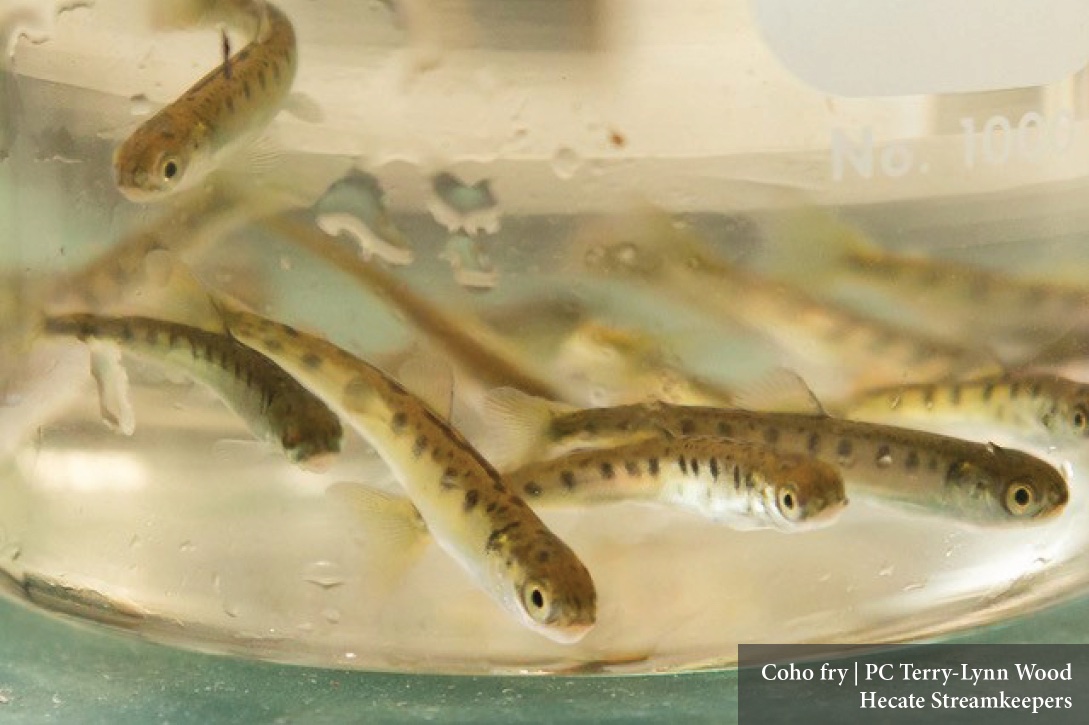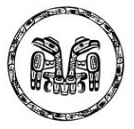| Snorkeling for Salmon - A Taay.yii Coho Census |
 |
| Written by Skil Gyaa.ans (Graham Richard) |
| 18 October 2023 |
|
The old Haida stories, called K’aygang.nga, tell of a child called Kul K’aluda. When he was still small, he went away with the salmon-people, and travelled to their village to live with them. One day the salmon-people gathered and followed the great crowds of herring-people home to Haida Gwaii. Kul K’aluda joined the huge schools of salmon as they arrived home. At the mouth of each inlet a large group of salmon-people would swim away from the main school and begin their journeys up into the many rivers that lead into the rainforests, bogs, lakes and mountains of the Islands. Haida Gwaii has 147 watersheds. A watershed is a system of creeks that join to form a river that empties into the sea. If you look at a map of Haida Gwaii, you can see how each of these watersheds reaches deep inland, with large rivers splitting into smaller and smaller creeks and rivulets. Together they look like the arteries of a living body, feeding into the bogs and rainforests and keeping the Islands alive. It is through this network of “arteries” that millions of salmon swim every year, bringing renewed life to Haida Gwaii. Their arrival brings a flurry of activity as taan Haida Gwaii black bear, ts’aag Bald eagle, and all kinds of seabirds come to feed on the fish. Since the time of our arrival during the ice age thousands of years ago, Haida have always cared for Haida Gwaii. In the past we managed the rivers, seas, bogs, forests and mountaintops through ‘waahlGahl, the potlatch legal system. Today Haida have built a fisheries program to help protect Haida Gwaii’s rivers. The program organises technicians who check on the health of salmon habitats. By counting how many salmon return every year, Haida can become better stewards of our territory. But how do we go about counting fish as they swim up the rivers? To get the job done Haida technicians don their dive suits and get ready to swim. With mask and snorkel gear at the ready, they get in the river and start counting! The beautiful taay.yii coho love to lay their eggs in gravel stream beds and they are right at home in the waters of Diina Gandlaay Deena River. Every Sk’aagii Kung September the river fills with taay.yii, and the many smells of autumn, the clamour of birds, and a surge of life follow. Diina Gandlaay is 15 km long and its watershed covers 65 square kms. The river is too big for one person to swim in a single day, so swimmers often do the job a little at a time with help from DFO technicians from their Community Economic Development Program. The swimmers pick a day when the water in the river is lower. With too much water the taay.yii spread out, and they’re harder to see. The swimmers drive upstream along a gravel road. They walk down to the riverbanks, plunge into the water, and start floating back down towards the sea again. A pair of friends walk along the riverbanks with the swimmers to help them and keep them safe. The waters of Diina Gandlaay churn energetically. The swimmers use diving masks to see underwater and have to keep a sharp eye to make sure they see all the taay.yii swimming. But in Sk’aagii Kung the taay.yii’s skins are full of colour, and at a distance the great schools of fish can sometimes sparkle like the stars of Taay.yan.nuhl the Milky Way. To disguise themselves the taay.yii gather in deep pools in the river or shelter under gnarly roots, branches, and riverbanks. This can make them harder to see. How do the swimmers know where to look? The coho counters shine their waterproof flashlights under riverbanks and log jams. They spot two or three hiding amidst the roots of an upturned tree. They quickly call out their count to their friends on shore who jot the number down in a notebook. As they drift downstream with the current, a large depression in the river appears. A few taay.yii swim up from the deep and rush past the swimmer. A few more follow, then suddenly a huge school of bright red salmon rises up and rushes past. The swimmer estimates their numbers as quickly as possible: “10, 20, 30, 50, 100, 150!” After counting, the swimmers leave the taay.yii to their business. The fish dig wide holes in the gravel of the riverbed. These fish nests are called “reds”. The men and women of the salmon-people mix their sperm and eggs together in the flowing river. The bright little taay.yii eggs fall into the red, where their parents carefully bury them. This will be the next generation - bright, beautiful orange eggs, hidden in the gravel of the streambed. The following K’ing.Gad spring little baby taay.yii, called fry, emerge. They will spend up to a year in the river before going to sea.
|






 Haida Fisheries Program is involved in marine management and conservation which includes conducting research and survey studies on various aquatic populations, including razor clams, sockeye, chinook and coho salmon, and herring that serve to improve the knowledge and understanding of the species . Offices are located at 272 Eagle Ave,
Haida Fisheries Program is involved in marine management and conservation which includes conducting research and survey studies on various aquatic populations, including razor clams, sockeye, chinook and coho salmon, and herring that serve to improve the knowledge and understanding of the species . Offices are located at 272 Eagle Ave, 



